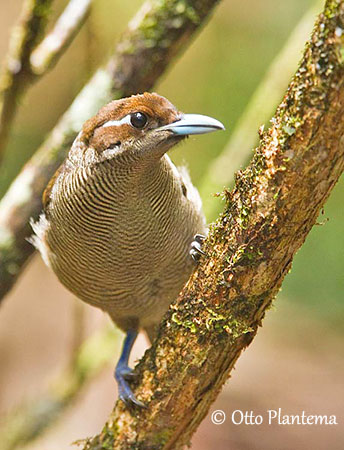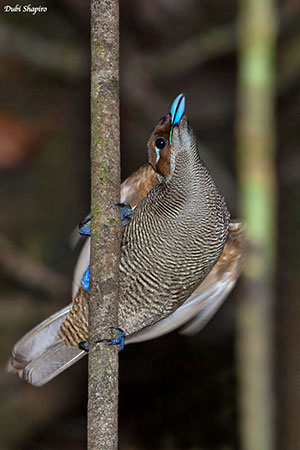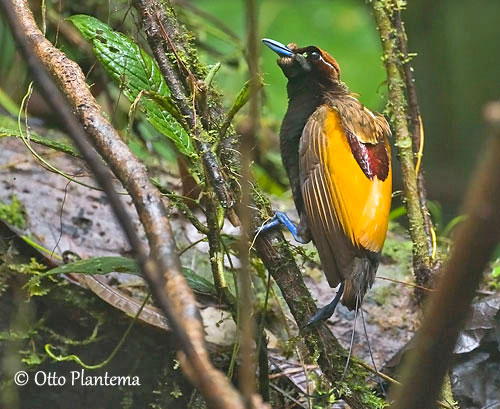
Fr: Paradisier magnifique
Ang: Magnificent Bird-of-paradise
All: Sichelschwanz-Paradiesvogel
Esp: Ave del Paraíso Magnífica
Ita: Uccello del paradiso magnifico
Nd: Geelkraagparadijsvogel
Sd: praktparadisfågel
Photographers:
Otto Plantema
Trips around the world
Dubi Shapiro
Dubi Shapiro Photo Galleries
Text by Nicole Bouglouan
Sources:
HANDBOOK OF THE BIRDS OF THE WORLD Vol 14 by Josep del Hoyo-Andrew Elliot-David Christie - Lynx Edicions – ISBN: 9788496553507
Les Oiseaux de paradis – Histoire Naturelle et photographies - par Michel Ottaviani - Editions Prin, France – ISBN : 2-909136-40-X
Birds of Paradise and Bowerbirds De Phil Gregory – Editeur: Bloomsbury Publishing, 2020 – ISBN: 1472975847, 9781472975843 – 416 pages
Birds of New Guinea: Second Edition De Thane K. Pratt, Bruce M. Beehler – Editeur: Princeton University Press, 2014 – ISBN: 0691095639, 9780691095639 – 528 pages
Birds of New Guinea: Distribution, Taxonomy, and Systematics De Bruce M. Beehler, Thane K. Pratt – Editeur: Princeton University Press, 2016 – ISBN: 069116424X, 9780691164243 – 672 pages
Book of Curious Birds De Jennifer Cossins – Editeur: Hachette UK, 2021 – ISBN: 073442048X, 9780734420480 – 64 pages
Astonishing Animals: Extraordinary Creatures and the Fantastic Worlds They ... De Tim Flannery – Editeur: Open Road + Grove/Atlantic, 2012 – ISBN: 0802194176, 9780802194176 – 192 pages
Bird: The Definitive Visual Guide De DK – Editeur: Dorling Kindersley Ltd, 2022 – ISBN: 0241596319, 9780241596319 – 512 pages
Compléments de Buffon, 2 - De René Primevère Lesson – Editeur : Garnier Frères, 1848 – Original provenant de la Bibliothèque Barcelona Athenaeum - Numérisé le 15 févr. 2010 – 733 pages
Animal Diversity Web (University of Michigan Museum of Zoology)
Kripkit - Diphyllodes magnificus
CREAGUS@Monterey Bay (Don Roberson)
Fatbirder - The World’s Richest Information Resource about Birds for Birders
Wikipedia, the free encyclopaedia
Magnificent Bird-of-paradise
Diphyllodes magnificus
Passeriformes Order – Paradisaeidae Family
INTRODUCTION:
The Magnificent Bird-of-paradise has a large range in Indonesia, New Guinea and some surrounding islands. It is found in the upper canopy of the rainforest, and almost exclusively in the mountains. Three subspecies share this range.
Like most Paradisaeidae species, it feeds primarily on fruits, but insects such as beetles and crickets are also part of its diet.
During the breeding season, the polygynous male performs elaborate courtship displays in a terrestrial court, calling and moving in order to attract females while exposing its iridescent bright-coloured plumage. The female builds and tends the nest alone.
The Magnificent Bird-of-paradise is described as widespread and common throughout the range. However, habitat loss and heavy hunting pressure involve some decline, but currently the species is not globally threatened.
DESCRIPTION OF THE BIRD:
Biometrics:
Length: M: 19 cm (26 cm with central rectrices) – F: 19 cm
Weight: M: 190 g – F: 128 g
The Magnificent Bird-of-paradise is fairly similar to the Wilson's Bird-of-paradise, except on the upperparts. Both males of these species have modified central rectrices similar to sickles.
The Magnificent Bird-of-paradise adult male has bright-coloured upperparts. On the back, the feathers coming from beneath the cape form a dark carmine semicircle bordered black with white iridescence. Lower back and rump are dark brownish-olive, the latter also with white iridescence. The dark-brownish-olive uppertail-coverts are tinged reddish-brown with dark green sheen. The tail is brownish-olive with modified central pair of rectrices, similar to sickles. The narrow web is only on the outer edge. It is iridescent green-blue above and olive-brown below.

On the upperwing, the lesser coverts are olive-brown with reddish-brown wash. The rest of the upperwing is dark brownish-olive with buff leading edges except on the outermost primaries, and broader on secondaries. The tertials are modified, with frill-edged buff tinge and orange-yellow wash with white iridescence.
On the underparts, chin and upper throat are brownish-black with dark green sheen. From lower throat to lower breast, the glossy dark green feathers form a conspicuous breast shield, and the elongate lower feathers extend onto the belly. The feathers of outer and lower breast are finely tipped turquoise to cobalt-blue.
During the displays, the feathers of the shield often show purple and/or magenta iridescence. Belly to undertail-coverts is blackish-brown with some violet-purple wash, depending on the light.
On the head, crown and nape feathers are short and ruffled. They are olive-brown with darker scalloped feather tips on central crown. They are mostly reddish-brown on sides of crown and on ear-coverts.
We can see a small, iridescent green spot on the lores, and a black semicircle of feathers above the eye. Behind the eye, a pale blue area of bare skin is often indistinct.
On the hindneck, the elongate, square-ended feathers are sulphur-yellow, and form a cape which refracts the white light. Several elongate olive-brown to reddish-brown feathers at side of the cape are tipped blackish.
The bill is pale grey-blue and the mouth is pale green. The eyes are dark brown. Legs and feet are blue.
The adult female has drab olive-brown to reddish-brown upperparts, whereas the underparts are whitish buff with dark brown barring.
On the head, we can see a thin line of pale blue skin behind the eye. The chin is olive-brown and the throat is whitish with brown flecks.
The tail is longer than that of the male, but the sickle-shaped central rectrices are absent.
The bill is duller and paler.
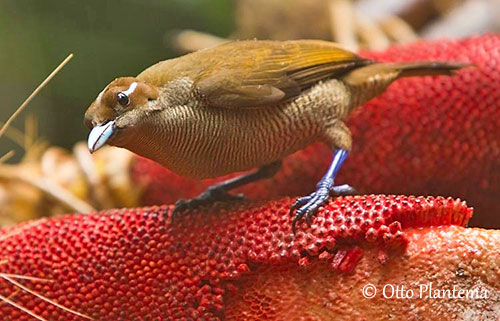
The juvenile is not described.
The immature male resembles adult female but it has blackish-brown bill.
The young male cannot display to attract a female until the two elongated rectrices grow in. This happens between three and six years after hatching. The full adult plumage is not acquired until at least six years.
SUBSPECIES AND RANGE:
The Magnificent Bird-of-paradise has three subspecies.
D.m. magnificus (described above) is found in West Papua Islands and NW New Guinea.
D.m. chrysopterus is found in W and C New Guinea and Yapen Island (off NW New Guinea).
This race is almost identical to nominate, but it differs by the secondary coverts and the outer edges of the flight-feathers which are more orange and less yellow. The crown is darker.
D.m. hunsteini is found in E Papua New Guinea.
This one resembles nominate but head and back are paler, with brighter orange on secondary coverts and outer edges of flight-feathers. Male and female are smaller than other races.
HABITAT:
The Magnificent Bird-of-paradise is usually found in the forested mountains of New Guinea, where it mainly frequents the upper canopy of the rainforest.
However, the species can be also seen in abandoned gardens in villages and small cities.
It is visible up to 1,780 metres of elevation, but mainly up to 1,400 metres.
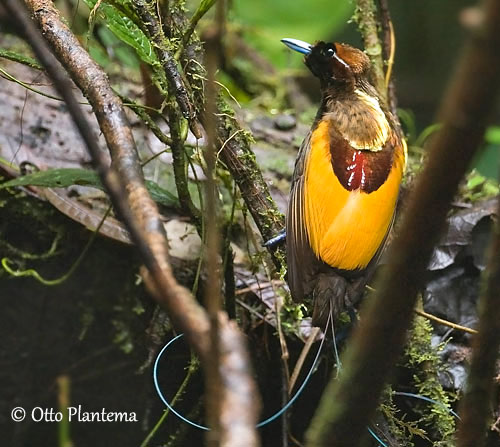
CALLS AND SONGS: SOUNDS BY XENO-CANTO
The Magnificent Bird-of-paradise uses several calls to communicate.
The advertising songs given by the male include a strident “ca cru cru cru” or a repeated, loud, clear “car” or “cre”, and also a hoarse “caaat ca ca ca”.
At court, the male gives a series of plaintive “churrs”, a single metallic “kyong” and a loud, sharp “kyerng”. We can also hear a scolding “ksss-kss-ks-ks-ks-kss” and also low clucking notes when disturbed.
The courtship displays are accompanied by various calls such as low, rhythmic, hard, clicking or buzzing sounds.
The adult male sometimes produces audible rattling or clacking sounds in flight.
BEHAVIOUR IN THE WILD:
The Magnificent Bird-of-paradise has diurnal habits and is a solitary species. It spends most of its time moving through the canopy of the forest in search of food.
It feeds primarily on ripe fruits and a small amount of insects, arthropods and other small invertebrates found in bark and lichens.
Outside of breeding season, they are seen in mixed foraging flocks including other species of birds-of-paradise, but also sunbirds (Nectariniidae) and other frugivorous bird species.
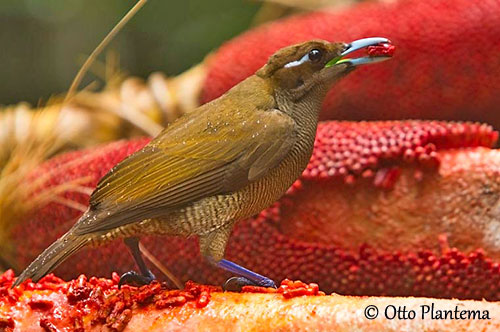
But during the breeding period, the polygynous male performs spectacular displays to attract females.
The male prepares a cleared area, a court, where it will display. It removes leaves and debris from the ground and fiercely defends the court from rival males.
This behaviour provides better visibility and improves its view of approaching females and predators. In the same way, the displays are enhanced and more conspicuous in this cleared area.
The court is often found on steep slopes, beneath a gap in the forest canopy. The owner spends much of the time perched on vertical saplings within the court.
The Magnificent Bird-of-paradise is not territorial but it maintains a home range around the court. This area usually overlaps with the home ranges of one or several other males. They maintain an auditory contact by calling while moving though these areas. A male may maintain a court for at least three consecutive years.
The courtship ritual of the Magnificent Bird-of-paradise is rather complex and codified. There are four display phases, the Back Display, the Breast Display, the Cape Display and the Dancing Display.
Each phase exposes a part of the male’s plumage, thanks to adapted postures. During these displays, the bird dances up and down the stem of a young tree with ritualized progression of movements of the nuchal cape, the pectoral shield, the curled central rectrices and the pale green cape.
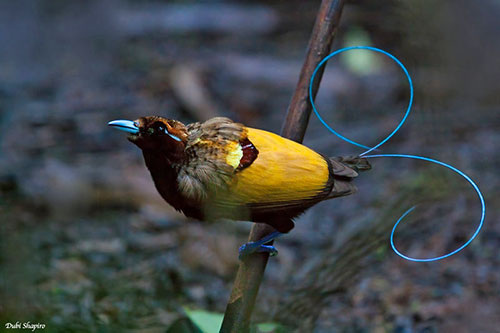
In the Back Display, the male exposes the bright colours of the back by turning upside-down on the perch. This position is held briefly before turning the head uppermost.
During the Breast Display, the male exposes the pectoral shield by inflating and deflating the iridescent feathers.
The silent Cape Display is performed when the female moves closer. The male leans almost horizontally with both neck and bill directed at her. The cape feathers are erect and fanned, whereas the breast shield is flattened and elongated. This posture is maintained for many seconds as the female approaches closer down the young tree.
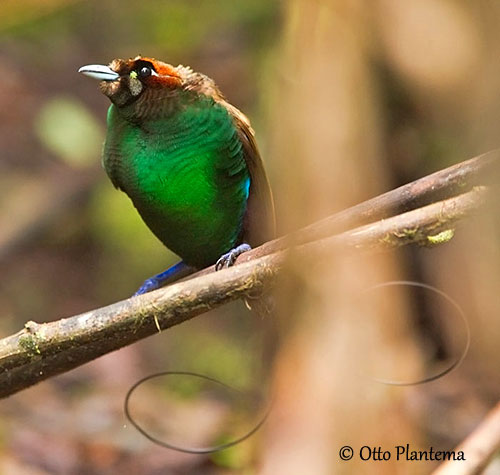
After mating, the female leaves the area. She will perform all the nesting duties without any help from the male.
The Magnificent Bird-of-paradise is probably resident.
While flying about the court, the male makes a sharp and clear clacking noise with the wings.
REPRODUCTION OF THIS SPECIES:
The breeding season takes place (at least) from July to December, but the species probably breeds in all months throughout the range.
The displays are possibly performed all year round, with peak between July and February.
The cup-shaped nest is built by the female alone in the canopy. It is made of mosses, dry leaves and weeds, and mammal fur is sometimes added. The cup is lined with softer materials, usually plant fibres and rootlets. It is often built in Pandanus crown, between 1 and 4 metres above the ground, or sometimes in dense foliage.
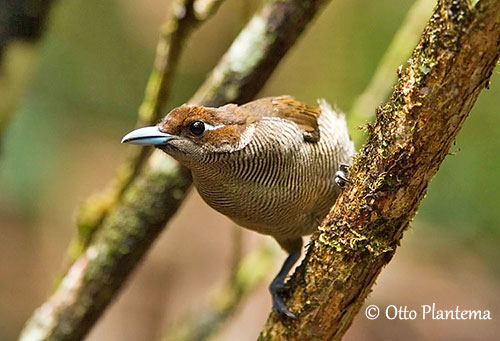
The female lays 1 or 2 creamy-white eggs and incubates during 18-19 days. The nestling period lasts 17-18 days. The young birds fledge about 30 days after hatching, although some young males may stick around for another month.
The females are sexually mature at about one year, and the males between 3 and 6 years, when they have the full adult plumage.
PROTECTION / THREATS / STATUS:
The Magnificent Bird-of-paradise is described as widespread and common.
The species is affected by habitat loss and heavy levels of hunting, because highland men wear the central tail wires of the adult males in their hair.
The size of the population is unknown, but it is suspected to be declining due to the previous threats.
However, the species is not considered globally threatened, and the Magnificent Bird-of-paradise is currently evaluated as Least Concern.
